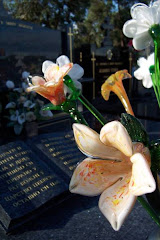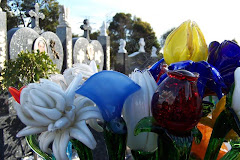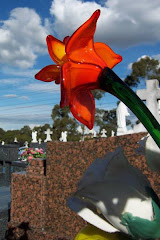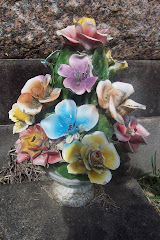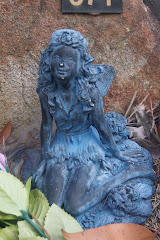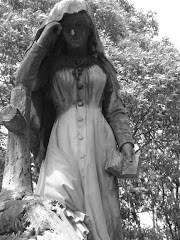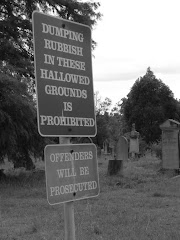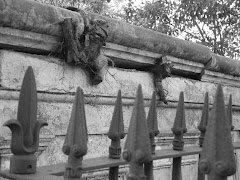Saturday, January 23, 2016
Thank you to those who still drop by and drop in a comment. As you can see from the last update it has been a long time since I last put up any new photos or information. I have had a child and life is busier than ever. However, I hope to go back to this blog again one day when time permits. In the meantime. Enjoy. A
Tuesday, December 6, 2011
Perth Cemeteries - revisited and new
I travelled to Perth to see my family in October this year. My Dad kindly took me along to Karrakatta Cemetery after we were foiled at the gates of the East Perth Cemetery (which was only open on Sundays) which we had planned on exploring. I have been to Karrakatta Cemetery before but it is a huge cemetery and found much to engage us again on this return trip. It is a huge place and there was lots to see. I have included some of the best pictures from this cemetery below and more will go into My Photographic Collection. I have include a few highlights below. We duly went back on Sunday to visit the East Perth Cemetery and found some interesting headstones and visited the little chapel within.
I have used some references material from "Stories in Stone: A Field Guide to Cemetery Symbolism and Iconography" by Douglas Keister in this blog. Fantastic book.
I have used some references material from "Stories in Stone: A Field Guide to Cemetery Symbolism and Iconography" by Douglas Keister in this blog. Fantastic book.
Ferns - symbols of humility, frankness and sincerity.
Urn - reverential accessory or symbol of the veil between earth and the heavens
Ivy - because it is always green, even in harsh conditions, it is normally associated with immortality and fidelity. It can also indicate attachment, friendship and undying affection because it clings for support. The three pointed leaves may also represented the Holy Trinity.
Hourglass - symbolic of time passing rapidly or as the hourglass can be inverted over and over again, it could suggest the cyclical nature of life and death.
Folded Acanthus?
Acanthus - the leaves of this plant are thorny and are often used to symbolise the 'prickly' journey from life to death and then to eternal life.
Celtic cross with clover and harp
Clover - symbol of the trinity. Legend says that St Patrick brought back the clover to Ireland to be an enduring symbol of the trinity. The clover, renamed the shamrock henceforth became the symbol of Ireland. It is also a symbol of vitality because of its abundant growth. Harp - source of divine music and associated with heavenly aspirations. Celtic Cross - the four arms can represented the four elements, or the four provinces of Ireland. The circle joining the four arms is referred to as the 'nimbus'. IHS - represents Christ's name in the greek alphabet: Iota, Eta, Sigma
Man and Child
Decaying figure with child
Laid down angel
Mary adored
Stigmata Jesus
Winged soldier
Tiny Mary
Saturday, July 9, 2011
Penrith here I come!!!
Went for an epic journey (it is epic if you live in Inner West Sydney) to Penrith to visit 4 more cemeteries on my list of locations. I was saddened to see one of them in a state of disrepair, gravestones laying all about the place and not much care in sight. This was in Jamistown, the Sir John Jamison Catholic Cemetery at the northern end of Lilac Place. I did take some shots there and was pleased to see a rather interesting headstone that depicted two angels holding up a crown together. This will be uploaded as soon as I can fix my photography software on my new virtual computer (long story).
The other three produced more interesting results. There are listed below with some small selections.
Other exciting news is that I found a fantastic book that I plan to have by me when entering new posts. It is titled: "Stories in Stone: A Field guide to Cemetery Symbolism and Iconography" by Douglas Keister. Apart from having entries on a huge range of the aforementioned, it also has fantastic collection of source photographs. I highly recommend it.
Other exciting news is that I found a fantastic book that I plan to have by me when entering new posts. It is titled: "Stories in Stone: A Field guide to Cemetery Symbolism and Iconography" by Douglas Keister. Apart from having entries on a huge range of the aforementioned, it also has fantastic collection of source photographs. I highly recommend it.
Brief History
| " |
The foundation stone for St Pauls Church was laid in 1847. Situated on a low hill overlooking the plains,
the cemetery includes some fine stone monuments associated with early families in the area.
The site was also the location of part of the prison quarters and kitchen garden of the Government
Farm established here in 1819." (Source: Penrith City Council Library)
An inscription list can be found HERE
|
I found, amongst other things, a Doc Marten boot on a grave, just one. Just to the side of another, a chicken's egg. Here is a selection of some other pictures from the site. I hope to have them up under My Photographic Collection before the new year (2012!)
Manger Scene
Elaborate Cross
Chicken Egg....
Broken Wing
Truckin'
Penrith General Cemetery
Cox Avenue, Kingswood
Cox Avenue, Kingswood
Rose Horse
Girl and Dolphins
Blue Mary
Happy Flower
Horse Heads
In the Aquarium
Boy and Hand
St Mary's General Cemetery
Great Western Highway, St Marys
Great Western Highway, St Marys
Friday, March 18, 2011
Cemeteries in the News!
Am planning to sort out all my New Zealand pictures (from a trip in January) of cemeteries there...but time seems to be hard to find.....Anyway. In the meantime, have found an interesting story on The Atlantic website focussing on a book about American Cemeteries. The link to the article can be found HERE
Monday, December 27, 2010
Missed it! - Castlebook Memorial Park Cemetery
I am not sure quite how this happened but as I am looking through my photographic collection and aligning it with my blog, I realise that I have photographed the Castlebrook Memorial Park Cemetery but not written anything about it or posted any photographs! So to rectify this I have set aside some space to include some information about the place and include 5 of the photographs from this excursion. The rest of the pictures can be see in my photographic collection, under Castlebrook Memorial Park Cemetery (cemeteries are listed alphabetically).
I am wondering what such items might be. It seems that crocodiles, cerebus and dinosaurs are ok.
Crocodile attack
Dinosaur topiary
Cerberus
(...which guards the gates of Hades, to prevent those who have crossed the river Styx from ever escaping.
Source: Wikipedia)
Angelic Cerebus (?)
Who is this?
Grandpa on the motorised scooter...complete with oxygen mask (!)
Castlebook Memorial Park Cemetery is located at Kellyville Ridge in Northwest Sydney. I couldn't find much information about it, or its history beyond the information given on the website. However, I did find the list of rules and regulations interesting. One of the rules points out that it is within the rights of the cemetery board to remove objects from gravesites:
"Prohibited items – We may refuse, rectify or remove any ornamentation or changes to a memorial or site. For example, we will not allow and will remove items such as artificial flowers, statues, permanent wreaths or spays, boxes, shells and toys and anything that we consider detracts from the beauty of the Park or is a safety hazard, or is in conflict with these Rules."
I am wondering what such items might be. It seems that crocodiles, cerebus and dinosaurs are ok.
Long time, no see.
It has been a long while since I have updated this blog...partly I think because I got busy but also because I am running out of cemeteries to visit within the inner Sydney region and so have to take the time to travel further and further out into the 'burbs' to see some new ones. I still have a list of 'cemeteries to visit' and I hope to get one fine day soon so I can go out with my camera. These include but are not limited to:
- Mona Vale Cemetery
- Forest Lawn Memorial Park
- Chatswood South Methodist Cemetery (no website)
- North Rocks Catholic Cemetery (not a direct link but the Catholic Cemetery website only has a page under construction for it)
Friday, July 9, 2010
Local Historic Cemeteries - City of Canterbury (Sydney)
It is really hard to find information on the internet about church cemeteries in Sydney. You can find websites with alphabetical lists of all cemeteries in Sydney (or indeed Australia - see: Australian Cemeteries Index), and some people have taken the time to make websites including cemeteries from their local area (see: Cemetery Records Australia) However, trying to find a list of churches which still have graveyards attached is a little bit tricky. If anyone knows of a good site (or is planning to create one!) please let me know.
Anyway, today I visited two small inner city cemeteries which I found through Cemetery Records Australia
The Canterbury City Cemeteries Online website includes a small amount of information on each of the sites I visited today and i have taken some of this for my blog (see below).
I noticed a bit of a pattern in both of the cemeteries which was a number of gravetsones that had text inlaid at the base with various readings including: "Resting", "Remembered", "Sleeping", "Thy will be done" etc. You can see these on the pictures below. I spend ages trying to work out one only to discover it was the name of those interred; "Plumridge".
Moorefield Cemetery
Moorefield Cemetery
I particularly liked this inscription on one headstone:
"This lovely bud so young & fair
called hence by early doom
Just came to show how sweet a flower
paradise will bloom"
Moorefield Cemetery
Moorefield Cemetery, Kingsgrove, NSW
"Moorefields Methodist Cemetery, Kingsgrove is located behind the church at 96a Moorefields Road, Kingsgrove (public access through Maramba Close). It is believed to be the oldest cemetery in Canterbury City with the first of over 1155 listed burials recorded on 6 January, 1855 for Emma Lees. The burial records can not be substantiated due to a fire destroying the early records in 1905.
Plots can no longer be purchased. Canterbury City Council is custodian of this cemetery and people with existing rights can arrange for relatives to be interred."
You can take a virtual tour of the cemetery or look at My Photographic Collection (soon to be updated) for more pictures of the site.
The Conservation Management Plan includes a layout of the cemetery, timeline history of the site and burial statistics amongst other information.
St Saviour's Cemetery, Punchbowl
From the Canterbury City Cemeteries Online website:
"The first recorded burial was for Catherine Elizabeth Pearson (age 36 years) on 19th February, 1878. There are many early pioneers of Canterbury City among the 1175 recorded burials"
You can take a virtual tour of the cemetery and find other information including details about the Church itself at the website.
Used the pinhole feature on my camera to take these shots
You can find out more information on both of these cemeteries from the publications of the Canterbury and District Historical Society.
Saturday, June 12, 2010
St Bartholomew's Church & Cemetery - Prospect
Ghost Tours included
After visiting Castlebrook Memorial Gardens Cemetery I did a search for cemeteries in the local area on my GPS. It is rather difficult to get a good list of all the cemeteries in Sydney, they are not particularly well indexed, so this is one way to find those small, out of the way places. This place was rather odd. In between huge the M4 and the Great Western Motorway it is shadowed by huge electricity towers. There is no real parking area, I had to turn off into a small drive way and walk up the hill to the church which is surrounded by large fencing and off-putting signs.
Searching the internet for information turned up this rather interesting link to Ghost Tours of the Cemetery. One happy customer reported: "t was a very cold night and i was freezing and shaking and then the tour guide asked me to sit on one of the graves and i stopped shivering and it suddenly wasn't cold anymore!"
Historical Information
"The Early Days..
 It was from the top of Prospect Hill that Captain Watkin Tench first saw the Blue Mountains in 1789.
It was from the top of Prospect Hill that Captain Watkin Tench first saw the Blue Mountains in 1789.
In 1791 Governor Phillip settled 12 families on small farms around the base of the Hill. These and later settlers were part of the Parish of St John's Church at Parramatta.
During the 1830s attempts were made to have an Anglican Church built at Prospect to serve the areas of Seven Hills and Prospect.
In 1838 William Lawson, resident at Veteran Hall Prospect, called for tenders to build the church. Prominent and local people had subscribed £376/3/- (approx. $750).
The Sydney Morning Herald of Saturday April 17 1841 reported that "On Wednesday last the Bishop of Australia laid the foundation of a Parochial Church at Prospect."
The Rev H H Bobart was appointed and performed the first services. The first baptism was of Margaret Goodin on May 2. 1841, the first marriage was of Thomas Moreing to Sarah McDonald on November 23 1841 and the first burial was of Ann Goodin, aged 15, on July 18 1841.
The church operated until the end of 1967 when it was closed due to increasing vandalism.
On Saturday November 4 1989 a fire gutted the church, destroying the roof and many of the interior fittings, including the organ and furniture.
During 1881-1889 renovations were made and the wooden ceiling was replaced by a metal one, in memory of Robert Crawford. Other memorial gifts included a reading desk, pulpit, new communion rail and handsome font cover.
After visiting Castlebrook Memorial Gardens Cemetery I did a search for cemeteries in the local area on my GPS. It is rather difficult to get a good list of all the cemeteries in Sydney, they are not particularly well indexed, so this is one way to find those small, out of the way places. This place was rather odd. In between huge the M4 and the Great Western Motorway it is shadowed by huge electricity towers. There is no real parking area, I had to turn off into a small drive way and walk up the hill to the church which is surrounded by large fencing and off-putting signs.
Searching the internet for information turned up this rather interesting link to Ghost Tours of the Cemetery. One happy customer reported: "t was a very cold night and i was freezing and shaking and then the tour guide asked me to sit on one of the graves and i stopped shivering and it suddenly wasn't cold anymore!"
Historical Information
"The Early Days..
In 1791 Governor Phillip settled 12 families on small farms around the base of the Hill. These and later settlers were part of the Parish of St John's Church at Parramatta.
During the 1830s attempts were made to have an Anglican Church built at Prospect to serve the areas of Seven Hills and Prospect.
In 1838 William Lawson, resident at Veteran Hall Prospect, called for tenders to build the church. Prominent and local people had subscribed £376/3/- (approx. $750).
The Sydney Morning Herald of Saturday April 17 1841 reported that "On Wednesday last the Bishop of Australia laid the foundation of a Parochial Church at Prospect."
The Rev H H Bobart was appointed and performed the first services. The first baptism was of Margaret Goodin on May 2. 1841, the first marriage was of Thomas Moreing to Sarah McDonald on November 23 1841 and the first burial was of Ann Goodin, aged 15, on July 18 1841.
The church operated until the end of 1967 when it was closed due to increasing vandalism.
On Saturday November 4 1989 a fire gutted the church, destroying the roof and many of the interior fittings, including the organ and furniture.
The Interior...
The church is a plain spacious building comprising a nave chancel and vestry. The tower at the western end had a bell, which was rung from inside the porch. The font, a large shallow bowl on a stone column and base, stood on a slightly raised platform at the back of the church on the left. Six very large kerosene lamps were suspended from the ceiling and there were small wall lamps on the eastern end. A number of marble memorial tablets were on the walls. High box pews provided the seating on the north and south sides, with low backed pews with kneelers in the centre. A hand pumped pipe organ stood at the right hand side. The large windows were of clear glass bordered all around by coloured glass about 13 cm wide.During 1881-1889 renovations were made and the wooden ceiling was replaced by a metal one, in memory of Robert Crawford. Other memorial gifts included a reading desk, pulpit, new communion rail and handsome font cover.
The Graveyard...
Many early settlers are buried in the graveyard. Among them are William Lawson, one of the first European settlers to cross the Blue Mountains and Thomas Willmot, the first Shire President of Blacktown" (Source: Blacktown: Historica St Bartholomew's Church)Sunday, May 23, 2010
Castle Hill Cemetery
Cemetery with a Virtual Tour!
The most amazing find on the internet about the Castle Hill cemetery is the virtual tour! I could only get it to play in Internet Explorer but it was rather cool. You can click on the different sections and look around. See if you can find the graves that I took photographs (see 5 photos below or the entry for this cemetery on my photographic collection *coming soon*)
"An 1897 Parish of Castle Hill map shows a large area bounded today by Showground and Gilbert Roads dedicated on 31 August 1895 for Public Recreation with a section reserved for a cemetery. The land, originally part of the 1801 Castle Hill Government Farm, had been included in a 165 acre Castle Hill Village Reserve set aside in 1861.
The NSW Government Gazette of 8 September 1902 stated that the land had been dedicated for a General Cemetery on 29 April 1881 and announced the appointment of Bruce Purser, Edwin George Crane, Clare Agrippa Gilbert, George Alexander Muir, Alfred William Bayly, Albert James James and Sylvanius Montefiore Charles Black as Trustees of the Church of England Burial Ground portion of the General Cemetery of Castle Hill.
The earliest burial in the Cemetery was in 1914 beside Cemetery Road as a fence had not been constructed to mark the boundaries. It was for George Philip Fitzroy who died 25 May 1914 aged 3 years 11 months. The first grave inside the fence (in the Anglican Monumental section) was also for another small boy, Robert James McKay who died 17 Feb 1918 aged 2 ½ years.
Originally Church of England (Anglican), Roman Catholic, Methodist (Uniting) and General sections were designated. A Cemetery Trust had been formed with representatives from each of the three local church groups. In June 1951 talks began about altering this and eventually a Local Government Act of 1967 transferred responsibility to The Hills Shire Council.
Since the late 1960s Lawns, Vaults, a Columbarium and Gardens have been added to accommodate the changing needs of our growing population. There are Anglican, Roman Catholic, Seventh-day Adventist, Presbyterian, Methodist, Muslim, Independent, Jewish and Baptist sections.
The Castle Hill Cemetery Entrance Gates, commissioned by Baulkham Hills Shire Council and designed by Giuseppe Organo of Fairfield, were dedicated in September 1978.
In 1967 Cemetery Road was renamed Gilbert Road after the Gilbert Family who had farmed extensive orchards for 100 years on land opposite the Cemetery and extending to Showground Road" (taken from Castle Hill History & Headstones)
Some more information on the cemetery:
"Castle Hill Cemetery is a unique haven located within a tranquil bushland setting, yet centrally placed
in the vibrant and growing residential suburb of Castle Hill. It is considered imperative that the peace,
tranquillity and natural beauty of the cemetery is maintained and enhanced in the future. To this end,
a Plan of Management has been commissioned to ensure that the cemetery continues to cater for
the needs of the community but also ensures the long term conservation and protection of the
remnant forest." Castle Hill Cemetery
in the vibrant and growing residential suburb of Castle Hill. It is considered imperative that the peace,
tranquillity and natural beauty of the cemetery is maintained and enhanced in the future. To this end,
a Plan of Management has been commissioned to ensure that the cemetery continues to cater for
the needs of the community but also ensures the long term conservation and protection of the
remnant forest." Castle Hill Cemetery
Away in a Manger
Rainproof grave figurine
Metal Jesus
Angel and a picket fence
Cemetery Cats
Cessnock Cemetery
Went to download some more photographs from my recent visit to Castebrook Memorial Gardens, St Bartholomew's and Castle Hill on Thursday and found these ones from Cessnock Cemetery unsorted. So, here is a taster of the ones from this cemetery situated right in the heart of the Hunter. Have to say that I was more impressed by the cemetery than the region in general - but this may have been due to my poor mood that the poor variety of sites to see.
The little history I found of Cessnock Cemetery include....
"Cessnock Cemetery is closed to new burials due to the high number of unmarked graves. Plots reserved prior to 1999 will be honoured." (Cessnock City Council)
Also on the Cessnock City council there was a few links to Cemetery related items including:
Grave Digger - specifications about Grave digging and what is involved....interesting...
The little history I found of Cessnock Cemetery include....
"Cessnock Cemetery is closed to new burials due to the high number of unmarked graves. Plots reserved prior to 1999 will be honoured." (Cessnock City Council)
Also on the Cessnock City council there was a few links to Cemetery related items including:
Grave Digger - specifications about Grave digging and what is involved....interesting...
Flaking angel
The detail on the wings of this angel are impressive
Moss layered hand
Subscribe to:
Comments (Atom)






















































